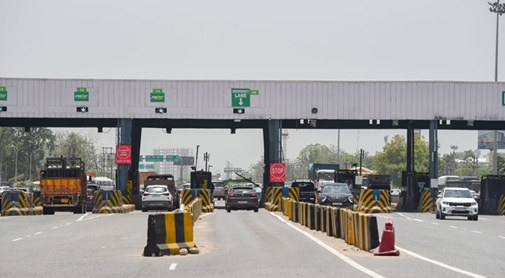(Prelims: Current Affairs)
(Mains, General Studies Paper- 2: Government policies and interventions for development in various sectors and issues arising out of their design and implementation) |
Reference
The Public Accounts Committee (PAC) of Parliament has recommended reforms in toll collection, including eliminating indefinite toll collection and increasing transparency. According to the data, toll collection is expected to reach Rs 55,000 crore in the year 2023-24, which is much higher than Rs 1,046 crore in the year 2005-06.

Meaning of Toll Collection
- Toll collection is a fee levied on vehicles using roads, bridges or highways to recover the cost of construction and maintenance.
- It is based on the concept of 'pay as you go' from users, where roads with more traffic are charged higher tolls.
- The money collected from toll is used for road repair, expansion and new projects.
- In India, there are toll plazas mainly on National Highways (NH), where toll is collected from cars, trucks etc.
Toll Rate Determination Process
- Toll rates are fixed on the basis of National Highway Fee (Determination and Collection) Rules, 2008, which are based on a uniform base rate across the country.
- It is not directly related to the construction cost or recovery. There is a fixed increase of 3% from 1 April every year. Also, there is a partial increase of 40% of the Wholesale Price Index (WPI).
- If the highway is built with public money, then the central government collects the toll and if it is built with BOT (Build Operate Transfer), TOT or Invit model, then the toll is collected by the private company (concessionaire).
- The 2008 amendment allowed toll collection indefinitely, after which the road is handed over to NHAI and the toll goes to the central exchequer.
Toll Collection Mechanism
- Vehicle arrives at toll plaza where scanner or staff collects fee based on vehicle type (car, truck etc.)
- Currently, FASTag is deducted automatically; without FASTag, double the fee is charged.
- Monthly pass (₹340) is given to those living within 20 km radius. 23 categories are exempted from toll, such as President, PM, Army, Ambulance etc.
- Toll is collected through cash, card or electronic mode and now GNSS-based barrierless system is being developed where ANPR cameras and FASTag will deduct toll quickly without stopping at toll plazas.
About FASTag
- FASTag is an RFID-based electronic toll collection system operated by NHAI. It is affixed on the vehicle and is automatically deducted from the bank account.
- Introduced in 2016, the system has now been made mandatory. Its benefits include faster travel, cashless and transparency.
- The current scheme offers an option of annual pass (from August 15) of ₹3,000 which works out to ₹15 per booth for 200 toll crossings.
- Future: Barrierless free flow tolling, with ANPR cameras.
Current laws and regulations
- Sections 7 and 9 of the National Highways Act, 1956 empower the Centre to levy toll on highways.
- National Highway Fee Rules, 2008: Determination of rates, collection and model (BOT, TOT, InvIT) In 2008, amendments were made to allow perpetual toll, i.e. NHAI has the right to collect toll on the road even after the period is over.
- Exemptions and exemptions: For local residents, VIPs, military etc.
- FASTag rules: Mandatory from 2021 and without FASTag the fee is double.
Concerns of PAC Parliamentary Committee
- The PAC headed by KC Venugopal submitted a report on August 12, recommending abolition of 'indefinite toll'.
- Toll continues even after the capital cost and maintenance is recovered.
- Fees are collected even when the quality and service level of the road decreases.
- The system of toll collection is not transparent.
- It is wrong to levy toll on roads under construction.
- Traffic jams persist despite FASTag implementation.
- Tolls should be discontinued or reduced after cost recovery; continuation should be approved by independent authority.
Ministry's response
- Ministry of Road Transport (MoRTH) has acknowledged PAC's concerns.
- A new toll system is being studied in collaboration with NITI Aayog.
- FASTag annual pass (₹3000/year) announced, which will provide benefit of crossing 200 tolls.
- Work is underway to create a barrier-less toll system –
- High-tech Fastag readers
- Automatic Number Plate Recognition (ANPR) cameras
Challenges
- Indefinite toll burdens users regardless of road quality or traffic
- Increase in corruption and lack of transparency
- Faults in Fastag technology and poor implementation
- Higher costs for small vehicles and rural population
- Lack of transparency: There is no relationship between rate and cost and there is no independent investigation.
- Despite recovery of Rs 1.9 lakh crore in 5 years, there is a lack of road damage and maintenance.
Way forward
- Toll should be abolished or reduced significantly after cost recovery.
- An independent regulatory authority should be created to review toll rates.
- A real-time monitoring system should be installed for transparency.
- Toll refund/discount system should be digitally linked to Fastag.
- Barrierless Tolling System (ANPR based) should be implemented quickly.
- Concessions should be ensured for rural and local users.



